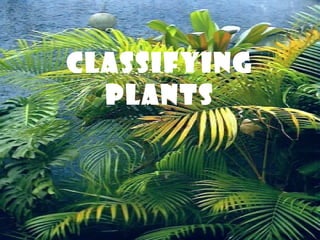Vascular nonvascular plants
•Download as PPT, PDF•
11 likes•24,739 views
Report
Share
Report
Share

Recommended
Recommended
More Related Content
What's hot (20)
Similar to Vascular nonvascular plants
Similar to Vascular nonvascular plants (20)
5 1-pharmacognostical profile of selected medicinal plants

5 1-pharmacognostical profile of selected medicinal plants
More from CDA-PamelaOrtiz
More from CDA-PamelaOrtiz (20)
Recently uploaded
https://app.box.com/s/7hlvjxjalkrik7fb082xx3jk7xd7liz3TỔNG ÔN TẬP THI VÀO LỚP 10 MÔN TIẾNG ANH NĂM HỌC 2023 - 2024 CÓ ĐÁP ÁN (NGỮ Â...

TỔNG ÔN TẬP THI VÀO LỚP 10 MÔN TIẾNG ANH NĂM HỌC 2023 - 2024 CÓ ĐÁP ÁN (NGỮ Â...Nguyen Thanh Tu Collection
God is a creative God Gen 1:1. All that He created was “good”, could also be translated “beautiful”. God created man in His own image Gen 1:27. Maths helps us discover the beauty that God has created in His world and, in turn, create beautiful designs to serve and enrich the lives of others.
Explore beautiful and ugly buildings. Mathematics helps us create beautiful d...

Explore beautiful and ugly buildings. Mathematics helps us create beautiful d...christianmathematics
Recently uploaded (20)
Python Notes for mca i year students osmania university.docx

Python Notes for mca i year students osmania university.docx
TỔNG ÔN TẬP THI VÀO LỚP 10 MÔN TIẾNG ANH NĂM HỌC 2023 - 2024 CÓ ĐÁP ÁN (NGỮ Â...

TỔNG ÔN TẬP THI VÀO LỚP 10 MÔN TIẾNG ANH NĂM HỌC 2023 - 2024 CÓ ĐÁP ÁN (NGỮ Â...
Mixin Classes in Odoo 17 How to Extend Models Using Mixin Classes

Mixin Classes in Odoo 17 How to Extend Models Using Mixin Classes
Unit-IV; Professional Sales Representative (PSR).pptx

Unit-IV; Professional Sales Representative (PSR).pptx
Basic Civil Engineering first year Notes- Chapter 4 Building.pptx

Basic Civil Engineering first year Notes- Chapter 4 Building.pptx
Explore beautiful and ugly buildings. Mathematics helps us create beautiful d...

Explore beautiful and ugly buildings. Mathematics helps us create beautiful d...
Food safety_Challenges food safety laboratories_.pdf

Food safety_Challenges food safety laboratories_.pdf
Vascular nonvascular plants
- 2. Standards: Students will be able to demonstrate how plants are sorted into groups. • Essential Questions: How is the classification of plants and animals similar and different?
- 3. Vocabulary to Know • Botanist • Vascular plant • Nonvascular plant
- 4. Plants • Plants do not have fur, scales, or blood, so how are they classified? Like animals, plants are divided into two main groups. Then these two groups are divided into smaller groups. The ways that plants get their food and the ways that they create new plants will help you classify them.
- 5. Who studies plants? A botanist is a scientist who specializes in the study of plants. They classify plants based on their characteristics (vascular and nonvascular). You could call them “Plant Explorers.”
- 6. How are they classified? • One way that plants can be classified is by how they carry water. Plants can either be Vascular or Nonvascular. • Vascular means “having tubes” • Nonvascular mean “not having tubes”
- 7. Vascular Plant Plants that have tubes, roots, stems, and leaves. These plants stand up tall.
- 8. Why are these trees vascular? They have tubes, roots, stems, and leaves. They also stand up tall.
- 10. Nonvascular Plant roots, stems, Plants that do not have tubes, or leaves. These plants soak up water and food from the soil, like sponges. They are also much smaller than vascular plants.
- 11. Why is this an example of a Non-Vascular plant? Non-Vascular Plants have no roots, stems, or leaves. They also don’t have any tubes.
- 12. Vascular or Non-Vascular? Non-Vascular
- 13. Vascular or Non-Vascular? Vascular
- 14. Moss on the Tree: Vascular or Non-Vascular? Non-Vascular
- 15. Vascular or Non-Vascular? Vascular